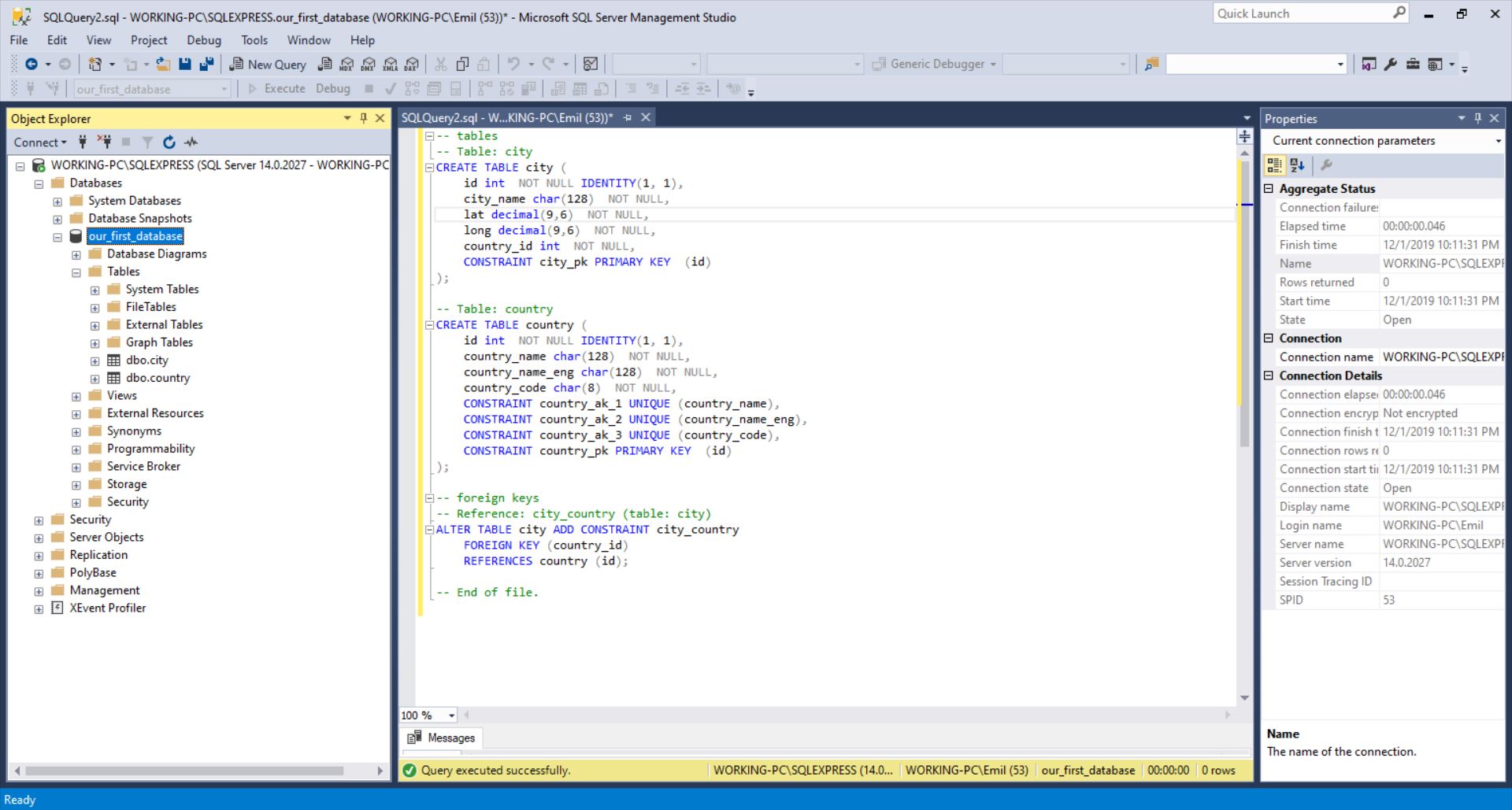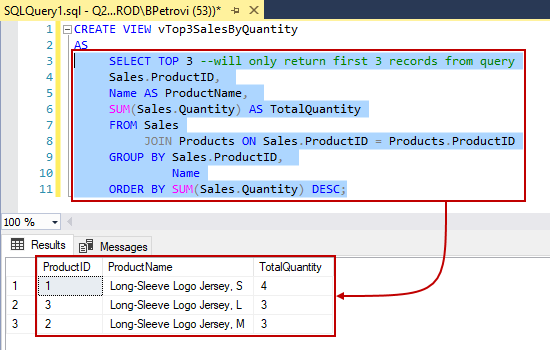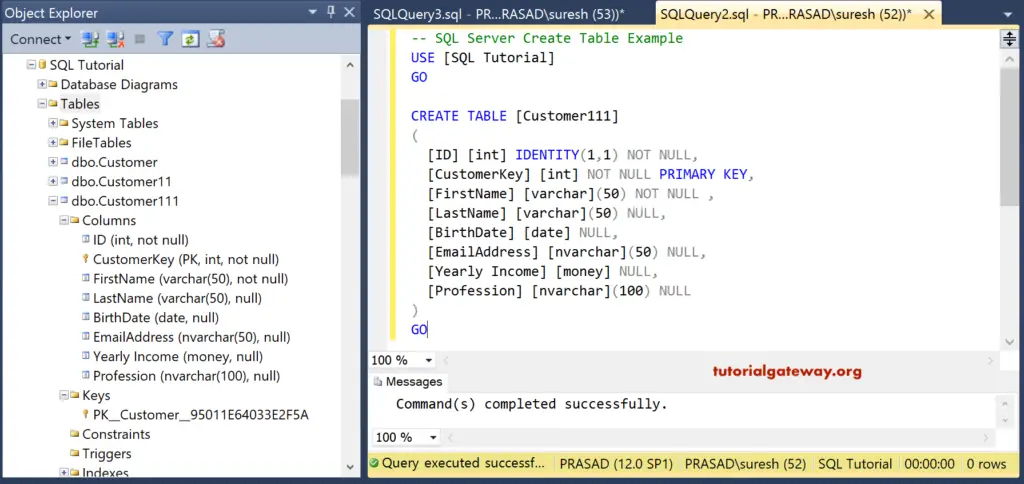A column relatives is a gaggle of columns which might be saved as a single key-value pair within the underlying key-value store. CockroachDB routinely teams columns into households to make certain competent storage and performance. However, there are circumstances when it's your decision to manually assign columns to families.
For extra details, see Column Families.table_constraintAn optional, comma-separated record of table-level constraints. For examples, see Create a brand new desk from an present one.opt_partition_byAn Enterprise-only possibility that allows you to outline desk partitions on the row level. See Define Table Partitions for extra information.opt_localitySpecify a locality for the table. In order to set a locality, the desk ought to belong to a multi-region database. A clause that specifies an present desk from which the brand new desk routinely copies column names, information types, and NOT NULL constraints.
The new desk and the father or mother desk are decoupled, and any alterations made to the father or mother desk aren't utilized to the brand new table. Default expressions for the copied column definitions are copied provided that INCLUDING DEFAULTS is specified. The default conduct is to exclude default expressions, in order that each one columns of the brand new desk have null defaults. Impala can create tables containing complicated variety columns, with any supported file format.
Because at present Impala can solely question complicated kind columns in Parquet tables, creating tables with complicated kind columns and different file codecs corresponding to textual content is of confined use. Constraint that specifies that a column or a couple of columns of a desk can include solely distinctive non-null values. Identifying a set of columns because the first key additionally can present metadata concerning the design of the schema. A main key implies that different tables can depend upon this set of columns as a singular identifier for rows. One main key might be specified for a table, regardless of whether as a single column constraint or a desk constraint.
The main key constraint have to identify a set of columns that's totally different from different units of columns named by any distinctive constraint outlined for a similar table. Each desk in SQLite could have at most one PRIMARY KEY. If the important thing phrases PRIMARY KEY are added to a column definition, then the first key for the desk consists of that single column. Or, if a PRIMARY KEY clause is specified as a table-constraint, then the first key of the desk consists of the record of columns specified as portion of the PRIMARY KEY clause.
The PRIMARY KEY clause have to comprise solely column names — employing expressions in an indexed-column of a PRIMARY KEY shouldn't be supported. An error is raised if multiple PRIMARY KEY clause seems in a CREATE TABLE statement. The PRIMARY KEY is non-compulsory for unusual tables however is required for WITHOUT ROWID tables. Data definition language statements allow you to create and modify BigQuery assets usingstandard SQLquery syntax. You can use DDL instructions to create, alter, and delete resources, reminiscent of tables,table clones,table snapshots,views,user-defined capabilities , androw-level entry policies.
Identifying a column because the first key promises metadata concerning the design of the schema. One main key would be specified for a table, regardless of whether as a column constraint or a desk constraint. In this example, we create the customers desk with a single main key column defined. The elective SORT BY clause enables you to specify zero or extra columns which are sorted within the info facts created by every Impala INSERT or CREATE TABLE AS SELECT operation.
Creating statistics information which might be sorted is most helpful for Parquet tables, the place the metadata saved inside every file comprises the minimal and most values for every column within the file. Each column consists of the column name, the type of knowledge that column stores, the size of data, and the column constraint. The column constraints specify regulations that statistics saved within the column have to follow. For example, the not-null constraint enforces the values within the column can't be NULL.
The column constraints include not null, unique, main key, check, overseas key constraints. Constraint that specifies that a gaggle of a number of columns of a desk can include solely original values. The conduct of the original desk constraint is identical as that for column constraints, with the extra functionality to span a number of columns. In the context of original constraints, null values aren't thought-about equal.
Each exclusive desk constraint should identify a set of columns that's totally different from the set of columns named by some different exclusive or main key constraint outlined for the table. The UPSERT and INSERT ON CONFLICT statements use a short lived desk referred to as excluded to manage uniqueness conflicts throughout execution. It's as a result not counseled to make use of the identify excluded for any of your tables.column_defA comma-separated record of column definitions. Column names should be exclusive inside the desk however can have the identical identify as indexes or constraints. To protect the partition information, repeat the identical PARTITION clause as within the exclusive CREATE TABLE statement.
Using the LIKE clause, you are in a position to create an empty desk with the identical knowledge varieties like within the outlined pattern desk or view. If you employ a pattern view and also you specify the choice INCLUDING COMMENTS, then all column remarks are adopted. If refcolumn is omitted, the first key of reftable is used. The referenced columns have to be the columns of a singular or main key constraint within the referenced table. Clause that specifies a overseas key constraint, which means that the column have to include solely values that match values within the referenced column of some row of the referenced table. The referenced columns ought to be the columns of a singular or main key constraint within the referenced table.
To see the column definitions and column feedback for an present table, as an instance earlier than issuing a CREATE TABLE ... AS SELECT statement, difficulty the assertion DESCRIBE table_name. To see much extra detail, resembling the situation of knowledge records and the values for clauses resembling ROW FORMAT and STORED AS, difficulty the assertion DESCRIBE FORMATTED table_name. DESCRIBE FORMATTED can additionally be wanted to see any total desk remark . The STORED AS clause identifies the format of the underlying statistics files. Currently, Impala can question extra kinds of file codecs than it could create or insert into.
Use Hive to carry out any create or information load operations that aren't presently accessible in Impala. For example, Impala can create an Avro, SequenceFile, or RCFile desk however can not insert information into it. There are additionally Impala-specific procedures for applying compression with every quite file format.
For particulars about working with files records of varied formats, see How Impala Works with Hadoop File Formats. The SORT BY columns can not incorporate any partition key columns for a partitioned table, due to the fact these column values usually are not represented within the underlying files files. Tables created with the LIKE choice do not inherit main and overseas key constraints. Distribution style, type keys, BACKUP, and NULL properties are inherited by LIKE tables, however you can not explicitly set them within the CREATE TABLE ... When the mother or father database is not really set because the default, the identify should be formatted as database.name.
If the unique desk is partitioned, the brand new desk inherits the identical partition key columns. Because the brand new desk is initially empty, it doesn't inherit the exact partitions that exist within the unique one. To create partitions within the brand new table, insert information or challenge ALTER TABLE ...
Similarly, an INSERT declaration might supply a worth to make use of because the rowid for every row inserted. Unlike natural SQLite columns, an integer main key or rowid column ought to include integer values. Integer main key or rowid columns are unable to carry floating level values, strings, BLOBs, or NULLs. Each row in a desk with a main key have to have a singular mixture of values in its main key columns. For the needs of figuring out the individuality of main key values, NULL values are thought of distinct from all different values, consisting of different NULLs. If an INSERT or UPDATEstatement makes an try to switch the desk content material in order that two or extra rows have similar main key values, that might be a constraint violation.
The following instance creates the method SelectFromTablesAndAppend, which takes target_date as an enter argument and returns rows_added as an output. The method creates a short lived desk DataForTargetDate from a query; then, it calculates the variety of rows in DataForTargetDate and assigns the consequence to rows_added. Next, it inserts a brand new row into TargetTable, passing the worth of target_date as one among many column names. Finally, it drops the tableDataForTargetDate and returns rows_added. To create an externally partitioned table, use the WITH PARTITION COLUMNSclause to specify the partition schema details.
BigQuery validates the column definitions in opposition to the exterior knowledge location. The schema declaration should strictly comply with the ordering of the fields within the exterior path. For extra details about exterior partitioning, seeQuerying externally partitioned data. The default undertaking of the references is fastened and doesn't rely upon the longer term queries that invoke the brand new materialized view. Otherwise, all references in query_expression should be certified with undertaking names. Specifies an present named file format to make use of for loading/unloading knowledge into the table.
The named file format determines the format sort (CSV, JSON, etc.), in addition to another format options, for info files. Clause that assigns a default info worth for the column. The info kind of default_expr have to match the info kind of the column.
Subqueries, cross-references to different columns within the present table, and user-defined features aren't allowed. If a schema identify is given, the brand new desk is created in that schema . If no schema is specified, the desk is created through the use of the present database schema.
If you're making a short lived table, you cannot specify a schema name, due to the fact that non permanent tables exist in a wonderful schema. In this example, we create the customers table, however with some column constraints. One column is the first key, and a different column is given a singular constraint and a look at various constraint that limits the size of the string. Primary key columns and columns with specific constraints are immediately indexed. Inside the parenthesis for the CREATE TABLE statement, you'll listing the names of the columns you need to create together with their knowledge varieties and constraints. The most easy structure for partitioned tables is with all of the partition key columns on the end.
The CTAS PARTITIONED BY syntax requires that column order within the decide upon list, leading to that very similar column order within the vacation spot table. In Impala 1.4.0 and higher, Impala can create Avro tables, which previously required doing the CREATE TABLEstatement in Hive. See Using the Avro File Format with Impala Tables for particulars and examples.By default , files recordsdata in Impala tables are created as textual content recordsdata with Ctrl-A characters because the delimiter. For extra examples of textual content tables, see Using Text Data Files with Impala Tables. It has the auto_increment property, therefore, MariaDB will immediately generate a sequential quantity while you insert a row into the table.
In addition, the project_id column is the first key specified by the first key constraint on the top of the table. It signifies that a worth within the project_id column will uniquely determine a row within the table. Fourth, specify desk constraints like main key, overseas key, check, and different after the column list. Such a column will likely be often called an "integer main key". A PRIMARY KEY column solely turns into an integer main key if the declared style identify is strictly "INTEGER".
Except for WITHOUT ROWID tables, all rows inside SQLite tables have a 64-bit signed integer key that uniquely identifies the row inside its table. The rowid worth might possibly be accessed utilizing considered one of several particular case-independent names "rowid", "oid", or "_rowid_" instead of a column name. So, the SELECT fact will return the column names and info types, however no data. Suppose you desire to deploy objects resembling tables, procedures, capabilities within the SQL Server database.
If you execute CREATE statements for these objects, and that object already exists in a database, you get message 2714, degree 16, state three error message as proven below. For extra details about legitimate names, see Names and identifiers. Prior to Impala 1.4.0, it was impossible to make use of the CREATE TABLE LIKE view_name syntax. In Impala 1.4.0 and higher, one could create a desk with the identical column definitions as a view employing the CREATE TABLE LIKE technique.
To specify a special file format, incorporate a STORED AS file_format clause on the top of the CREATE TABLE LIKE statement. For Kudu tables, you specify logical partitioning throughout a variety of columns making use of the PARTITION BY clause. In distinction to partitioning for HDFS-based tables, a wide variety of values for a partition key column might be situated within the identical partition. The optionally available HASH clause allows you to divide one or a set of partition key columns right into a specified variety of buckets. You can use a wide variety of HASH clause, specifying a definite set of partition key columns for each.
The non-compulsory RANGE clause additional subdivides the partitions, situated on a set of assessment operations for the partition key columns. Of the underlying knowledge documents and strikes them once you rename the table, or deletes them once you drop the table. For extra about inner and exterior tables and the way they work together with the LOCATION attribute, see Overview of Impala Tables.
Table, the place the info records are regularly produced exterior Impala and queried from their unique places in HDFS, and Impala leaves the info records in place while you drop the table. For particulars about inner and exterior tables, see Overview of Impala Tables. With the CREATE TABLE AS SELECT and CREATE TABLE LIKE syntax, you don't specify the columns at all; the column names and kinds are derived from the supply table, query, or info file. The above fact creates a desk named individuals with 4 columns id, name, birth_date and phone. Notice that every column identify is observed by a knowledge kind declaration; this declaration specifies that what variety of knowledge the column will store, even if integer, string, date, etc. A UNIQUE constraint is analogous to a PRIMARY KEY constraint, besides that a single desk could have any variety of UNIQUE constraints.
For every UNIQUE constraint on the table, every row have to embody a singular mix of values within the columns recognized by the UNIQUE constraint. For the needs of UNIQUE constraints, NULL values are thought-about distinct from all different values, consisting of different NULLs. As with PRIMARY KEYs, a UNIQUE table-constraint clause have to embody solely column names — using expressions in an indexed-column of a UNIQUE table-constraintis not supported. AS SELECT statement, a CREATE TABLE consists of a number of column definitions, optionally observed by an inventory oftable constraints. Each column definition consists of the identify of the column, optionally observed by the declared style of the column, then a number of non-compulsory column constraints.
The different constraints - NOT NULL, CHECK, UNIQUE, PRIMARY KEY and FOREIGN KEY constraints - impose restrictions on the desk data. It will likely be an error to aim to create a brand new desk in a database that already incorporates a table, index or view of the identical name. An error remains to be returned if the desk can't be created on account of an present index, even when the "IF NOT EXISTS" clause is specified. The variety of columns within the column identify listing should match the variety of columns within the underlying SQL query. If the columns within the desk of the underlying SQL question is added or dropped, the view turns into invalid and should be recreated. For example, if the age column is dropped from the mydataset.people table, then the view created within the prior instance turns into invalid.


























